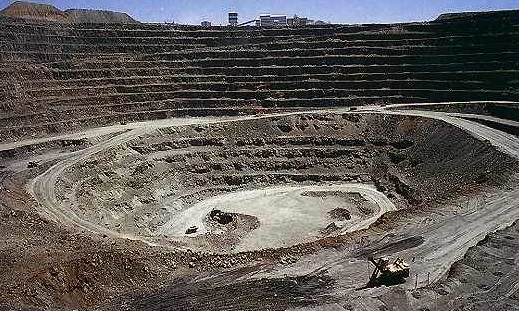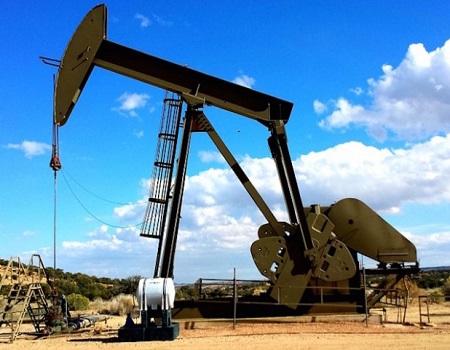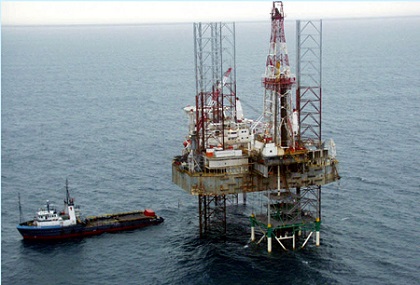i) Veins and Lodes
- Occurrence of minerals in crevices, cracks or faults in igneous rocks.
- Veins - Occur there in small quantities.
- Lodes - Occur there in large quantities e.g. zinc, copper and silver.
ii) Reef
- Veins and lodes which are exposed on the surface.
iii) Seams/Layers/Beds
- Occurrence of minerals as sedimentary or as a result of compression of
accumulated organic or inorganic material e.g. coal and halite.
iv) Alluvial Deposits
- Occurrence of minerals while mixed with materials such as sand, gravel, silt, etc.
These were minerals which were detached from the veins by weathering and
carried away by streams and rivers and got deposited e.g. gold, diamond and
platinum.
v) Weathering Products
- Minerals formed by deep weathering of rocks then leaching carried minerals from
the top to lower layers where they accumulated e.g. aluminium, nickel, iron and
manganese.
vi) Oil pools/Wells
- Occurrence of minerals in pools or wells in sedimentary rocks e.g. petroleum and
natural gas.
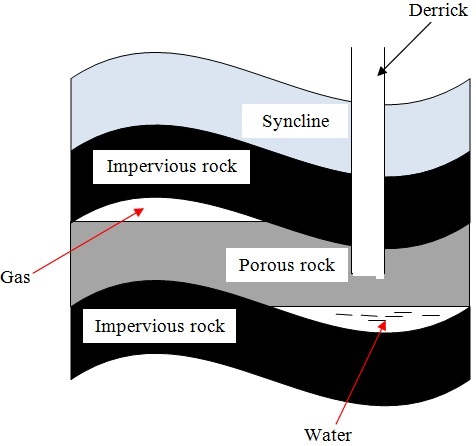
- Presence of fossils or organic remains
- Presence of sedimentary rocks for burying organic remains
- Presence of pressure to compress organic remains to cook the oil and natural gas out of organic matter
- Presence of a porous reservoir rock to store and transmit petroleum to the oil pools e.g. limestone and sandstone
- Presence of a trap like a syncline to hold petroleum in a reservoir to prevent its escape
- Presence of impermeable rocks below the trap or syncline to prevent petroleum from percolating further underground
Factors Influencing Exploitation of Minerals
1. Value of Mineral
Minerals of high value will be mined even if they occur in small quantities because
one sold it will be possible to offset mining costs and make a profit and vice versa.
2. Quality of Ore
Mining can be done if the mineral deposits have high mineral content because they
are economical to work on but deposits with low mineral content are rarely worked
on except if the mineral in them is rare e.g. uranium.
3. Size of Deposit
Minerals which aren't of high value have to occur in large quantities for them to be
mined so that it will be a possible to recover mining costs and make a profit.
4. Capital
Lack of capital causes developing countries not to exploit minerals and leave it to
international companies because a lot of money is needed for exploration,
infrastructure, salaries, energy etc e.g. titanium mining at Kwale is being done by
Tiomin company from Canada.
5. Method of Mining
A mineral requiring open cast mining will be mined even if the mineral deposit is
large but one requiring underground mining will be extracted if its in large deposit
or if its of high value or rare.
6. Transport costs
Minerals occurring in remote areas far from the markets are not likely to be
exploited if the transport system is poorly developed since mineral ore is heavy and
bulky and transporting it by road and railway is expensive.
7. Market for the Mineral
Mining can be done if the mineral is in demand and if the prices are reasonable so
that mining costs are offset and a profit is realized.
8. Political Influence
Mineral deposits at the borders of two countries may not be exploited as a dispute
may arise concerning whom mine it e.g. dispute between Iraq and Kuwait over
Rumaila should oil field.
9. Labour
Exploitation of some minerals require skilled workers and if they lack it may not
be done as is the case in developing countries because expatriates have to be
engaged and are very expensive to pay which may reduces the profits accruing
from mining.
1. Open Cast Mining
- Method of extracting minerals which are near the earth's surface.
- The types of open cast mining include:
a) Stripping
- Stripping off of the unwanted material lying on top of the mineral deposit and
then digging to remove the mineral bearing rock if it's soft or if it's hard
explosives may be used to loosen it and then huge power shovels are employed to
dig up the mineral deposits.
b) Hill-slope Boring
- Using boring instruments known as augers to drill out mineral deposit and bring it
to the surface.
2. Underground Mining
- Method employed when the mineral lies very deep below the surface and the
overburden is too thick to be removed by mechanical means.
- The types of underground mining include:
a) Shaft Method
-Method employed when the mineral bearing rock doesn't out crop.
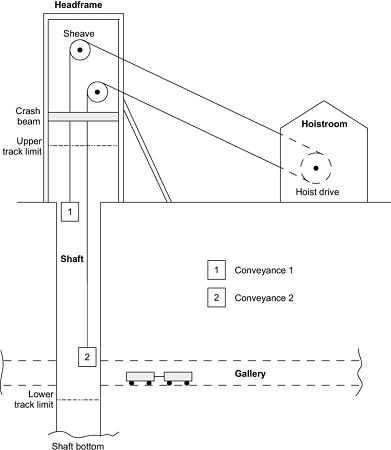 How it's carried Out
How it's carried Out
- Vertical shafts are sunk into the earth's crust to reach the layer with the
mineral.
- Horizontal tunnels are dug from the vertical shaft to reach the mineral.
- Props are erected to support the roof to prevent it from collapsing.
- The mineral bearing rock is blasted loose by explosives.
- The deposit is transported on light rail or conveyor belt to the bottom of the
shaft.
- It is then brought to the surface in a crane or a lift called cage.
b) Drift/Adit Mining
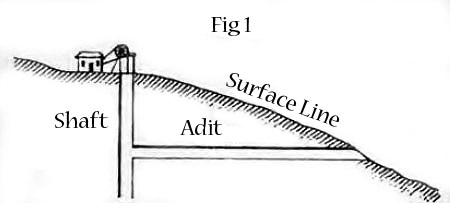
- Method employed when the mineral deposit can be reached from the valley sides.
- Horizontal tunnels (adits) are constructed from the side of the hill.
- Railway line is constructed into the mine to bring out the mineral e.g.
mining of copper at Kilembe in Uganda.
c) Solution Method
- Method used in mining soluble minerals such as sulphur, salt, potash, etc.
- Superheated water is ejected into salt deposits.
- The mineral dissolves or melts.
- The solution is then pumped into the surface.
d) Drilling
- Method employed in exploitation of petroleum.
- Wells (oil derricks) are drilled.
- Oil and natural gas are brought to the surface under their own pressure or
by pumping.
3. Alluvial/Placer Mining
-Method used to extract minerals occurring in alluvial deposits e.g. gold, tin,
diamonds and platinum.
- The types of alluvial/placer mining include:
a) Panning
It involves:
- Digging a mixture of sand, gravel and mineral from the river bed.
- Putting it in a pan and rotating the pan while tilted.
- The lighter sand or gravel is washed on the side leaving the heavier mineral
at the bottom of the pan e.g. gold mining in Migori and R. Morun Beds in
W. Pokot.
b) Dredging
- A dredger scoops water logged alluvium from the bed of a lake.
- The alluvium is passed over sloping channels with series of traps.
- Wastes are washed away and denser materials are left at the bottom of the
trap e.g. mining of soda ash at L. Magadi.
c) Hydraulic Mining
-Method used when alluvial deposit occurs on a valley side.
- A powerful jet of water is directed at the deposit.
- Gravel and mineral collect at the valley because of the great pressure.
- The mineral grains are recovered and washed out.
d) Sub-marine Mining
-Method employed in extracting minerals in alluvial deposits lying deep down the
ocean floor.
- A sub-marine dredger goes down the ocean floor.
- It scoops mineral deposit and rises to the surface.
- The alluvium is passed over sloping channels with series of traps.
- Wastes are washed away and denser materials are left at the bottom of the
trap.
Significance of Minerals/Mining in Kenya
1. Kenya earns foreign exchange from exportation of minerals which is used to
import goods and services and fund development projects.
2. Mining is a source of employment to people such as those who work in mines,
in cement factories, in transport sector, etc.
3. Mining has led to development of industries by providing raw materials used in
those industries e.g. limestone used in cement factories, coal used in iron and
steel industries, soda ash used in glass industry, etc.
4. Mining has led to development of transport system to make mining areas
accessible e.g. Magadi soda mine is connected to the main Mombasa-Nairobi
railway line.
5. Mining has led to development of settlements e.g. Magadi town which
originated from the mining of soda ash.
6. Mining is a source of market for goods and services e.g. there are shops and
markets, banking and insurance services offered to people working in mines
and related industries.
7. Has led to development of social amenities by providing social facilities such
as housing, health, electricity, water and education alongside infrastructure.




